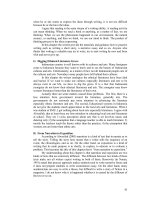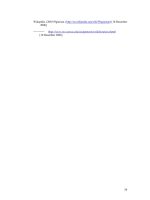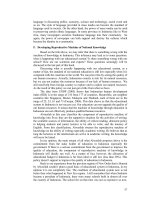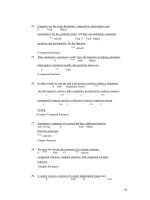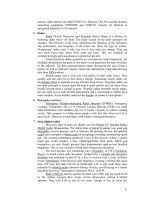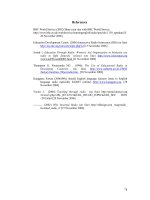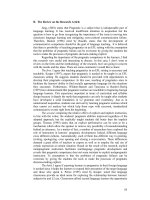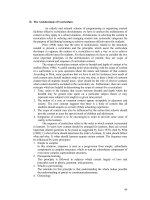Teaching and learning english literature
Bạn đang xem bản rút gọn của tài liệu. Xem và tải ngay bản đầy đủ của tài liệu tại đây (1.18 MB, 241 trang )
Teaching & Learning
English Literature
.
Teaching & Learning
English Literature
Ellie Chambers & Marshall Gregory
SAGE Publications
London ( Thousand Oaks ( New Delhi
Ellie Chambers and Marshall Gregory, 2006
First published 2006
Apart from any fair dealing for the purposes of research or
private study, or criticism or review, as permitted under the
Copyright, Designs and Patents Act, 1988, this publication may
be reproduced, stored or transmitted in any form, or by any
means, only with the prior permission in writing of the
publishers, or in the case of reprographic reproduction, in
accordance with the terms of licences issued by the Copyright
Licensing Agency. Enquiries concerning reproduction outside
those terms should be sent to the publishers.
SAGE Publications Ltd
1 Oliver’s Yard
55 City Road
London EC1Y 1SP
SAGE Publications Inc
2455 Teller Road
Thousand Oaks, California 91320
SAGE Publications India Pvt Ltd
B-42, Panchsheel Enclave
Post Box 4109
New Delhi 110 017
British Library Cataloguing in Publication data
A catalogue record for this book is available from the British
Library
ISBN-10 0-7619-4171-1 ISBN-13 978-0-7619-4171-2
ISBN-10 0-7619-4172-X ISBN-13 978-0-7619-4172-9 (pbk)
Library of Congress Control Number: 2005934569
Typeset by TW Typesetting, Plymouth, Devon
Printed in Great Britain by Athenaeum Press, Gateshead
Printed on paper from sustainable resources
Contents
Acknowledgements
Teaching and Learning the Humanities in Higher Education
Foreword
Introduction
vii
ix
xi
1
1
The discipline today
In crisis?
From ancient pedagogy . . .
. . . To the modern academy
Intrinsic justification
5
5
10
25
37
2
What is good teaching?
‘Teaching’ and ‘good teaching’
An approach to teaching close reading: textual analysis and
interpretation
Postscript
40
40
3
Teaching literary theory and teaching writing
‘Positioning’ literary theory
Approaching the teaching of theory and criticism
Teaching theory and criticism
Approaches to teaching academic writing
Academic literacies
Writing pedagogy
Postscript
63
63
68
72
80
84
86
89
4
Planning for teaching: curriculum and course design 91
‘Modelling’ curriculum design
91
The curriculum
95
Curriculum aims
97
Subject benchmarking
99
49
61
vi
Teaching & Learning English Literature
Course design issues
Progression
Models of curriculum design revisited
Postscript
5
107
114
118
120
Methods of teaching
‘Good teaching’ revisited
Teaching beginning students: socio-cultural pedagogic
principles
Working methods: methods that work
Electronic teaching methods
Postscript
122
122
6
Student assessment
Transparent assessment criteria and standards
Designing an assessment regime
Feedback and learning
Various forms of assessment
Postscript
161
162
168
176
182
190
7
Evaluating teaching; future trends
Evaluating courses and teaching
Trends
193
193
205
Bibliography
Index
Appendices
(on the book’s website: www.sagepub.co.uk/chambers.pdf)
1 Text of ‘Araby’
2 Teaching theoretical orientations: a tutorial
3 Sample curricula
4 Sample exam papers
5 Generic and graduate skills
6 Sample course assessment designs
7 Electronic sources
125
135
156
158
212
223
Acknowledgements
Many colleagues and students have contributed to this book – on both
sides of the Atlantic, in formal discussion and conversation – sometimes unwittingly. To all of them, thank you. In particular, thanks
should go to Wayne Booth, whose conversations and collaborations
with Marshall Gregory over four decades have been foundational to
Gregory’s views about teaching, and to the many faculty members
who over the years have participated in Gregory’s pedagogy seminars.
Conversations with them have given him a level of intellectual
stimulation and motive for thinking through pedagogical issues that
all too few faculty members are fortunate enough to receive.
In addition, we would like to acknowledge valuable contributions to
the book from the following colleagues: Ann Dashwood, University of
Southern Queensland; Dr Sara Haslam (Arts Faculty) and Dr Mary Lea
and Simon Rae (IET), the UK Open University; Professor Graham
Gibbs, University of Oxford, and Claire Simpson. We would also like
to thank Professor Ben Knights (Director) and the staff of the Higher
Education Academy English Subject Centre, Royal Holloway London,
for use of their exemplary website.
Special thanks go to Nigel Blake, Philosopher of Education, who
read and made insightful comments on all the draft chapters. And to
our series editor, Jan Parker, who has carried out her task sympathetically and imaginatively. Our thanks, too, to Sage Publications and their
editors: patient, forbearing and highly professional colleagues. Finally,
we would like to thank our partners and families for their much
appreciated encouragement and support throughout the composition
and revision of the manuscript that eventually turned into this book.
.
Teaching and Learning
the Humanities in Higher
Education
SERIES EDITORS: Ellie Chambers and Jan Parker, The Open
University
This series for beginning and experienced lecturers deals with all
aspects of teaching individual arts and humanities subjects in higher
education. Experienced teachers offer authoritative suggestions to
enable beginning and experienced lecturers to become critically
reflective about discipline-specific practices.
Each book includes an overview of the main currents of thought in
a subject; major theoretical trends; appropriate teaching and learning
modes and current best practice; new methods of course delivery and
assessment; electronic teaching methods and sources.
Features include:
discussion of key areas of pedagogy: curriculum development,
assessment, teaching styles, professional development, appropriate use of C⁢
case study illustration of teaching certain problematic topics;
the findings of educational research and sample material of all
kinds drawn from a range of countries and traditions;
suggestions throughout for critical decisions, and alternative
strategies and follow-up activities, so that all teachers are encouraged to reflect critically on their assumptions and practices.
The series sets out effective approaches to a wide range of teaching
and teaching-related tasks.
The books are intended as core texts for lecturers working towards
membership of the Higher Education Academy, for adoption by
training course providers, and as professional reference resources. The
x
Teaching & Learning English Literature
books are also suitable for PGCE, and Further and Higher Education
courses. In countries with less formal plans for lecturer training but a
longer tradition of serious attention to pedagogy within the higher
education culture, the series will contribute to the scholarship of
teaching and learning and professional and organisational development.
Series titles:
Modern Languages: Learning and Teaching in an Intercultural Field
Alison Phipps and Mike Gonzalez
Teaching and Learning History
Geoff Timmins, Keith Vernon and Christine Kinealy
Teaching and Learning English Literature
Ellie Chambers and Marshall Gregory
Ellie Chambers is Professor of Humanities Higher Education in the
Institute of Educational Technology, The Open University, UK. Since
1974 she has worked as a pedagogic adviser, evaluator and researcher
with colleagues in the university’s Faculty of Arts. In 1992 she founded
the interdisciplinary Humanities Higher Education Research Group
and in 1994, with colleagues, the national Humanities and Arts Higher
Education Network. She regularly addresses conferences internationally and has published widely in the fields of distance education
and Arts and Humanities higher education – including the best-selling
book for students, The Arts Good Study Guide (1997, with Andrew
Northedge). Currently, she is founding Editor-in-Chief of Arts and
Humanities in Higher Education: An International Journal of Theory,
Research and Practice (Sage) and a Member of Council, the Society for
Research into Higher Education.
Dr. Jan Parker is a Senior Research Fellow of The Open University’s
Centre for Research in Education and Educational Technology and
chairs the Humanities Higher Education Research Group. Founding
editor of the Sage journal Arts and Humanities in Higher Education: An
International Journal of Theory, Research and Practice and Executive
Editor of Teaching in Higher Education (Taylor and Francis), she still
teaches and writes on her disciplinary specialisation, Greek Tragedy,
and is a Senior Member of the Faculty of Classics, Cambridge. She is
currently co-writing the Teaching and Learning Classics and Classical
Studies volume of this series.
Foreword
Those of us working in the national English Subject Centre are acutely
conscious of a paradox. That is that the family of English subjects in
British universities study communication in a very sophisticated way,
and harbour a wide variety of pedagogic methods. Since its inception,
the subject has been committed to what we now know by the
portmanteau phrase ‘learning and teaching’. Yet, by and large,
university teachers of English – in Britain at all events – find it hard
to make their tacit pedagogic knowledge conscious, or to raise it to a
level where it might be critiqued, shared or developed. In our
experience, colleagues find it relatively easy to talk about curriculum
and resources, but far harder to talk about the success or failure of
seminars, how to vary forms of assessment, or to make imaginative
use of Virtual Learning Environments. Too often this reticence means
falling back on default assumptions about student learning, about
teaching or about forms of assessment. There is a real question as to
where new pedagogic understandings may be formed. Thus we are
aware that many starting lecturers and their colleagues pass severe
judgements on the university diploma courses they are required to
take. Meanwhile, for those who seek to support English lecturers, there
is a shortage of subject-specific material to recommend.
Ellie Chambers’ and Marshall Gregory’s timely book cannot provide
all the answers, but it will be found an invaluable resource by new
(and not so new) lecturers in English Literature. It is a thoroughly
researched and stimulatingly detailed addition to the kind of dialogue
that the English Subject Centre seeks to foster. While rich in practical
ideas, it is not simply a compendium of tips. It sets out to ground its
suggestions in a theorised account of the subject – an account which
attends to the grammars that govern the interaction between teachers
xii
Teaching & Learning English Literature
and students, the protocols of dialogue and assessment, and above all
to the collaborative nature of the productive processes in which both
teachers and students engage. The underlying argument is that
‘content and pedagogy are inseparable’ [p. 25]. The practical consequence is that the methods teachers choose should be sensitively
attuned to the specific demands of what they are trying to achieve.
This book is articulated along two complementary lines of thought.
The authors rightly refuse to be drawn into what they describe as the
‘knee-jerk reaction that teaching is inherently suspect’ [p. 42]. While
we all have much to learn from the learner-centred orthodoxies of the
last quarter century, teachers nevertheless have responsibilities towards their subject and towards their students. At the same time even
a passionate commitment to the subject needs to be complemented by
hard, careful thought about curriculum and module design, and about
the structuring of seminars. For the other half of the argument is that
‘we cannot assume that our students just know how to read a literary
text’ [p. 47]. Nor do they intuitively know how to take part in a
seminar discussion. While the responsibility of the teacher is to create
and hold the spaces in which learning can take place, that does not in
itself entail a vow of silence. The teacher also has the role of modelling
the discourse, and while it may sometimes be appropriate to withhold
his or her superior knowledge, there are also occasions when it is just
as appropriate to share it. In this light, Chambers and Gregory provide
a wealth of detail about module design, seminar process, assessment,
and feedback, modelling the process of dialogue as they do so.
The great strength of this book is that it is grounded simultaneously
in pedagogic theory and in ‘an approach to teaching in which literary
experience is taken to be an important form of human learning . . .’
[p. 149]. Enriched by this dual focus, it promises to become a welcome
contribution to the teaching of university English.
Ben Knights
Director, English Subject Centre
Higher Education Academy
Introduction
Whether or not the discipline of English Literature is ‘in crisis’ is
something we consider right at the start of this book. But if not in
crisis, it is certainly a discipline in the process of marked change.
Curriculum, syllabus, teaching and student assessment methods all
are pressured by significant social and political forces. In recent times,
for example, these forces and government policies have produced:
a ‘massification’ of higher education, with no commensurate
increase in resource for teaching;
a dominant discourse of the marketplace;
a related instrumental pedagogic discourse of measurable ‘learning outcomes’ and skills ‘transferable’ to the workplace, underpinned by a so-called learner-centred ideology;
increased resource for and dependence on information and
communication technologies (ICTs);
a convergence of distance and conventional education and the
emergence of a ‘blended’ form of learning for all.
The study and teaching of English is also shaped by our students’
purposes and the conditions in which they live and work, and by
academics’ shifting ideas about the nature of the discipline and its
relationship to other, adjacent, fields. In the modern world, can we still
talk about English Literature or should we substitute Literatures in
English? What is Literature’s wider relationship to Media and Film
Studies, and Cultural Studies?
At the start of the book we take it as axiomatic that there is an
identifiable discipline of English literature, that it has certain central
characteristics and outer limits. But, as the book progresses and we
examine the curriculum and our teaching and assessment methods in
more detail, boundaries become less distinct. Perhaps limits come to
seem more like limitations. Or maybe they just matter less.
2
Teaching & Learning English Literature
Believing, with Max Weber, that man is an animal suspended in a web
of significance he himself has spun, I take culture to be those webs, and
the analysis of it to be therefore not an experimental science in search of
law but an interpretive one in search of meaning.
(Geertz, 1975: 5)
Perhaps, after all, the search for meaning is something that unites the
Humanities.
If this hypothesis is worthy of at least provisional acceptance, it
follows that the study and teaching of literature will play a central role
– and has always played a central role – in human beings’ search for
meaning. Literature, as a subset of story, acts, as do all other forms of
story, to perform such all-important functions as telling human beings
what is important in life, telling us what’s worthy of our admiration
or our contempt, telling us what it’s like to be those who live in
different circumstances and in other historical times and in other
gendered bodies, telling us what we should pay attention to and what
we can afford to ignore, and, in short, telling us how life might be lived
this way rather than that way. Among the many different ways that the
Humanities search for meaning, deploying our resources for reading
literature well and teaching it effectively must be among the most
important resources we can deploy in general, not just for disciplinary
purposes but for the more broadly educational purposes of preparing
our students for their overall lives, for their careers, for parenthood,
for civic responsibility and for moral and ethical thoughtfulness.
The book differs somewhat in its aims from others of its kind (for
example, Showalter, 2002; Agathocleus and Dean, 2002; Widdowson,
1999). Written by a US English professor and an educationist with an
academic background in Literature, it aims to introduce its audience
to an analysis of how educational ideas – both ‘classic’ texts and recent
research – illuminate our subject. Literature is always at the heart of
things, but from there we try to move ‘out’ to make fruitful
connections to current educational thinking. Readers may, or may not,
like to follow those leads. In the UK, where new university lecturers
will soon be required to gain a teaching qualification, the need may be
most pressing. We hope that the book will at least get them started –
and from a basis in the discipline.
The first three chapters are designed to act as an introduction,
especially for those who are beginning or relatively new teachers of
Literature. There we ‘show’ as well as tell, demonstrating a close-
Introduction
3
reading seminar class and (on the book’s website) a tutorial on an
approach to teaching literary theory and criticism. We also discuss
approaches to teaching essay writing, specifically via the writing
workshop. And so we explore some of the main ‘problems’ involved
in teaching Literature (teaching close reading, theory and writing)
while also demonstrating some of Literature’s main teaching methods
(the seminar, tutorial and workshop).
Thereafter, we hope that the book’s appeal is broader. Chapter 4
onwards takes the reader from planning the curriculum and courses
in Literature, through a range of modern teaching-learning methods,
to the issues surrounding student assessment – and finally, in Chapter
7, to evaluation of our work and performance as teachers. This whole
planning process, perhaps presented somewhat seamlessly, is in
reality messier. But, nonetheless, we trust that discussion of it raises
some important issues for teachers, illuminated by the sample course
outlines (including essay and exam questions) and assessment regimes
presented on the book’s website.
These example courses and regimes are drawn mainly from practice
in the UK (although readers may use the web addresses offered in the
Bibliography and Appendix 7 on the website to access literature course
models from Australia and North America). This emphasis reflects the
fact that, in the UK, the government and its agencies now make certain
demands of teachers of all disciplines. For example, the UK Quality
Assurance Agency requires that teachers in higher education should
stipulate certain demonstrable ‘outcomes’ of their programmes, as
regards the students’ content knowledge and skills, to specified
standards. And we demonstrate in the book that similar accountability
and quality assurance measures are being introduced elsewhere.
Looking at the situation in the UK – the ‘worst case’, as it were – is
therefore instructive all round.
But, in addition to this, some educators are becoming involved in
what is now termed a ‘scholarship of teaching’ (discussed in Chapter
7) – incorporating new media in their teaching, taking a more
systematic interest in what goes on in the classroom or online and in
their students’ learning, asking questions about what they do and
why. For them teaching is becoming less a job and more an intellectual
activity worthy of serious consideration and investigation. This might
just put an end to what George Levine (2001: 7) describes as ‘the split
between our work as teachers and our work as scholars’. Although he
acknowledges that at present ‘within the scholarly universe of the

